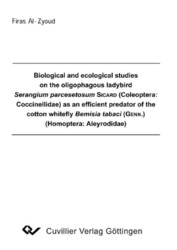| Areas | |
|---|---|
| Serie de libros (96) |
1379
|
| Nachhaltigkeit |
3
|
| Gesundheitswesen |
1
|
| Letra |
2367
|
| Ciencias Naturales |
5407
|
| Matemática | 229 |
| Informática | 319 |
| Física | 980 |
| Química | 1364 |
| Geociencias | 131 |
| Medicina humana | 243 |
| Estomatología | 10 |
| Veterinaria | 108 |
| Farmacia | 147 |
| Biología | 835 |
| Bioquímica, biología molecular, tecnología genética | 121 |
| Biofísica | 25 |
| Nutrición | 45 |
| Agricultura | 1004 |
| Silvicultura | 201 |
| Horticultura | 20 |
| Ecología y conservación de la tierra | 148 |
| Ciencias Ingeniería |
1793
|
| General |
98
|
|
Leitlinien Unfallchirurgie
5. Auflage bestellen |
|
Erweiterte Suche
Biological and ecological studies on the oligophagous ladybird Serangium parcesetosum SICARD (Coleoptera: Coccinellidae) as an efficient predator of the cotton whitefly Bemisia tabaci (GENN.) (Homoptera: Aleyrodidae) (Tienda española)
Firas Al-Zyoud (Autor)The current research aimed to study the biology of the little known, in the literature, whiteflies predator, Serangium parcesetosum SICARD (Col., Coccinellidae) at low and high temperatures for the biological control of Bemisia tabaci (GENN.) (Hom., Aleyrodidae) in the laboratory. The prey consumption as well as the prey consumption preferences by S. parcesetosum was also determined. Further experiments were devoted to record the egg-laying behavior of the predator. Moreover, experiments were conducted to investigate the biology and prey consumption by this ladybird with the greenhouse whitefly, Trialeurodes vaporariorum WESTWOOD (Hom., Aleyrodidae) as prey. Additionally, the biology of B. tabaci as a main prey was stated at different temperatures and plant species. Finally, greenhouse experiments were set up to evaluate the efficiency of S. parcesetosum as a biological control agent of B. tabaci. In the laboratory, the results showed that B. tabaci has completed its development, survived and reproduced at all temperatures and plant species tested. The predator, S. parcesetosum was able to successfully develop, survive and reproduce when fed on B. tabaci at 18±1°C and 30±1°C on cotton and cucumber. A wide range of crop and ornamental host plant species of B. tabaci was found to be suitable for the predator’s oviposition. S. parcesetosum larval instars and adults were able to prey upon B. tabaci nymphs and puparia at both studied temperatures. The predatory adults had adapted smoothly to fluctuating prey availability and could live for a considerable period of time on 10% honey emulsion. The ladybird showed a preference for B. tabaci puparia over nymphs and eggs as well as preferred B. tabaci and T. vaporariorum to the non-whitefly prey species offered. It tended to avoid parasitized puparia of B. tabaci by the parasitoid, Encarsia formosa GAHAN (Hym., Aphelinidae). The presence of the predator, Chrysoperla carnea (STEPHENS) (Neur., Chrysopidae) had influenced the egg-laying behavior of S. parcesetosum, which was also able to develop, survive, reproduce and prey upon T. vaporariorum as prey at 30°C on cucumber. Under greenhouse conditions, it was found that the release of a pair of S. parcesetosum adults per plant caused a reduction in the population of B. tabaci reached up to 90.7% and 86.5%, when the predator was released 1 and 2 weeks after infestation with the whitefly.
Das Ziel der vorliegenden Arbeit war es, die Biologie des in der Literatur wenig bekannten Räubers Serangium parcesetosum SICARD (Col., Coccinellidae) bei niedrigen und hohen Temperaturen für die biologische Bekämpfung von Bemisia tabaci (GENN.) (Hom., Aleyrodidae) im Labor zu untersuchen. Weiterhin wurden die Prädationsleistung und das Präferenzverhalten des Räubers erfasst. Eben so erfolgten Experimente zur Oviposition sowie Untersuchungen über die Biologie und Prädationsleistung von S. parcesetosum mit Trialeurodes vaporariorum WESTWOOD (Hom., Aleyrodidae) als Beute. Auch die Untersuchungen zur Biologie von B. tabaci bei unterschiedlichen Temperaturen und Pflanzenarten waren Gegenstand diese Arbeit. Abschließend erfolgte eine Untersuchung über die Wirksamkeit des Prädators gegenüber B. tabaci in Gewächshaus. Die Ergebnisse der Laboruntersuchungen zeigten, dass B. tabaci in der Lage war, sich erfolgreich bei allen getesteten Temperaturen und Pflanzenarten zu entwickeln und zu vermehren. Der Räuber S. parcesetosum konnte sich erfolgreich mit B. tabaci als Beute bei 18±1°C und 30±1°C auf Baumwoll- sowie Gurkenpflanzen ernähren, entwickeln und vermehren. Ein großes Spektrum von Wirtspflanzen für B. tabaci erwies sich als geeignet zur Eiablage von S. parcesetosum. Sowohl die Larven als auch die Adulten von S. parcesetosum konnten sich mit B. tabaci-Nymphen und -Puppen bei beiden getesten Temperaturen ernähren. Die Adulten des Prädators passten sich leicht an ein wechselndes Beuteangebotend an und konnten für eine beträchtliche Zeit mit 10%igem Honig-Emulsion überleben. Der Marienkäfer bevorzugte mehr Puppen von B. tabaci als Nymphen und Eier. Des weiteren bevorzugte er eher B. tabaci und T. vaporariorum als andere Beute und vermied es von Encarsia formosa GAHAN (Hym., Aphelinidae) parasitierte B. tabaci-Puppen als Beute zu fressen. Die Anwesenheit des Prädators Chrysoperla carnea (STEPHENS) (Neur., Chrysopidae) hatte einen Einfluss auf das Eiablageverhalten von S. parcesetosum und er konnte sich ebenfalls erfolgreich mit T. vaporariorum als Beute bei 30±1°C auf Gurken entwickeln, ernähren und vermehren. Unter Gewächshausbedingungen konnte eine 90.7% bzw. 86.5% Reduzierung von B. tabaci bei Freilassung von einem paar S. parcesetosum pro Baumwollpflanze erzielt werden, wenn die Freilassung 1 bzw. 2 Wochen nach dem Infizieren der Pflanzen mit der Weißen Fliege erfolgte.
| ISBN-10 (Impresion) | 386537381X |
| ISBN-13 (Impresion) | 9783865373816 |
| ISBN-13 (E-Book) | 9783736913813 |
| Idioma | Alemán |
| Numero de paginas | 100 |
| Edicion | 1 |
| Volumen | 0 |
| Lugar de publicacion | Göttingen |
| Lugar de la disertacion | Göttingen |
| Fecha de publicacion | 01.03.2005 |
| Clasificacion simple | Tesis doctoral |
| Area |
Agricultura
|








